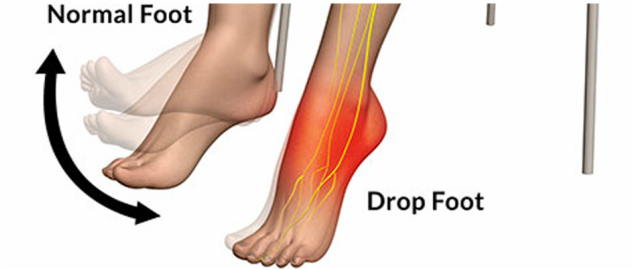Physiotherapy Treatmet of Foot drop or Injection Palsy
Foot drop or drop foot refers to the inability to lift off the front part of the foot. It can occur because the nerve, muscles or tendon responsible for the movement have been damaged. The most common cause is injury or trauma to peroneal nerve, a nerve which supplies the muscles and helps in transmission of sensation in the foot. Foot drop is usually a symptom of another problem rather than a disease itself. Because the ability to lift off the foot is a critical part of the way we walk, foot drop often affects the gait.
In Nigeria, the term injection palsy is commonly used interchangeably with foot-drop. Unfortunately, injection palsy is quite common in children this is because, children are still frequently given injection in the buttocks area and since they don’t have muscle bulk or fat pads in the region, they are more susceptible to the nerve being injured by the injection needle. This is one of the reasons injections should only be given as a last resort to children, mothers are advised to ask questions pertaining this whenever they have to visit the hospital and injection is suggested.
Causes of foot drop
Nerve Injury/Compression of the Nerve
- During surgery such as Total Hip Replacement and Total Knee Replacement
- While giving injection to the buttocks area
- During pregnancy or labour
Spinal problems/Compression of nerve
- Herniated disc
- Spinal stenosis
- Spondylolisthesis
- Vertebral fractures
Brain or Spinal cord disorders
- Stroke
- Multiple Sclerosis
- Cerebral Palsy
Muscle Disorders
- Muscular dystrophy
- Polio
- Amyotrophic Lateral sclerosis
Trauma
- Fractures
- Gunshot injury
- Injection
Diagnosing foot drop
Foot drop is usually diagnosed by clinical signs. That means by taking a history, examining the foot and depending on the symptoms, a diagnosis can be made. In more severe cases where there is a systemic health problem, trauma or delayed healing, radio-diagnostic tests such as X-ray, MRI, Ultrasound and CT-scan may be used to understand the cause or contributing factor to the foot drop.
Speciality tests such as electromyography and nerve coduction tests may also be required in some cases to check muscle activity and nerve damage
Symptoms of foot-drop
- High steppage gait
- Pain and hypersensitivity
- Weakness and Wasting of the muscles
- Exaggerated hip hiking and swinging
- Difficulty doing certain movements
Physiotherapy management of foot-drop or injection palsy
Most types of foot-drop can be resolved conservatively in extreme cases, surgery in form of nerve graft or tendon transplant may be required.
Physiotherapy focuses on pain management and hypersensitivity in the acute stage using cryotherapy, anaesthetic ointment, and soft tissue mobilisation.
Stimulation in form of electrical functional stimulation may also be used concurrently
Orthotic foot support in form of toe raise may also be recommended
Prognosis
Depending on the cause, the prognosis varies. Foot-drop caused by compression resolves faster than foot drop caused by stroke or muscle disease while foot drop in a child resolves faster than that in an adult. PhysioCraft experience with managing foot drop varies from a child who had injection palsy which resolved after 3 weeks to an adult who was a victim of gunshot injury who’s symptom made good progress but not full recovery even after 8 months despite doing a nerve conduction test which showed no nerve damage.
If you have further questions, contact the PhysioCraft team on +2348035670888 or +23421781940921 and we would be happy to answer your questions for free.


